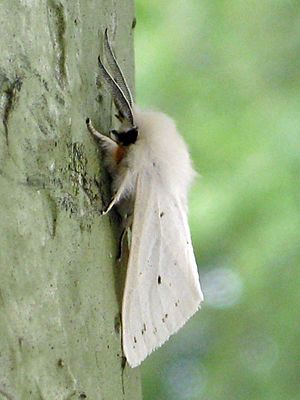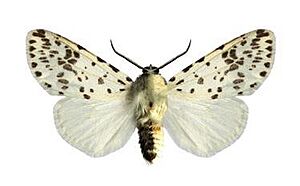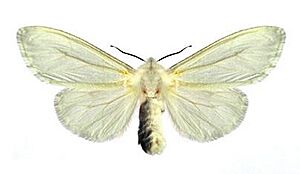Fall webworm facts for kids
Quick facts for kids Fall webworm |
|
|---|---|
 |
|
| Scientific classification |
The fall webworm (Hyphantria cunea) is a type of moth from the Erebidae family. It is mostly known for its caterpillar stage. These caterpillars build special silky nests on the branches of many different hardwood trees. You can usually see these nests in late summer and fall. Even though the nests might look a bit messy, the fall webworm usually does not harm healthy trees. Tree experts often know about them.
Contents
Description
The adult fall webworm moth has wings that spread about 30 millimeters (about 1.2 inches) wide. Most of these moths are white. However, some might have dark spots on their wings.
Distribution
This moth first came from North America, where it lives from Canada all the way to Mexico. It is one of the few insects from North America that has spread to other parts of the world.
In the 1940s, it arrived in what was then Yugoslavia. Since then, it has spread across Europe, from France to the Caspian Sea. It has also moved into Central Asia, including countries like Turkmenistan, Uzbekistan, Kyrgyzstan, and southeastern Kazakhstan.
The fall webworm also reached Japan in 1945. It has learned to adjust how many generations it has each year there. It has also spread to China, southern Mongolia, Korea, and parts of Russia. This means it is now found in many places around the world. The fall webworm spread so quickly because of things like trade and fast travel.
Life cycle
In the northern parts of North America, the fall webworm usually has one generation each year. The caterpillars appear from late summer through early fall. If you go south of about 40°N latitude, there are two or more generations every year. The further south you go, the earlier the webs start to appear.
Eggs
The adult female moth lays her eggs on the underside of leaves. She covers these egg clusters with her body hairs. Each cluster can have a few hundred eggs. The eggs usually hatch in about one week.
Larva
The caterpillars can look very different from each other. Their colors range from pale yellow to dark gray. They have yellow spots and both long and short bristles (hairs). They also have two cream-colored stripes along their sides.
There are two main types of fall webworm caterpillars. One type is more common in the north, and the other is found more in the south. They differ in the color of their head. These caterpillars can grow up to 35 millimeters (about 1.4 inches) long.
The webs they build get bigger and look much messier than those made by tent caterpillars. Tent caterpillars only appear in spring and have shorter hairs with very little yellow on their bodies. Also, fall webworm webs are usually at the tips of branches. Tent caterpillar webs are mostly found where branches join.
Young caterpillars eat only the top surface of leaves. As they get older, they eat whole leaves. The caterpillar stage lasts about four to six weeks. These caterpillars are known to wiggle together at certain times. It's still a mystery how they all manage to do this at the same time, especially when they are spread out.
Pupa
The pupa stage is when the insect rests and changes. The fall webworm pupa spends the winter hidden in tree bark or in fallen leaves at the bottom of trees. It is dark brown and about 10 millimeters (about 0.4 inches) long. The pupa is inside a thin, brown cocoon. This cocoon is made of silk mixed with small bits of dirt and leaves.
Adult
Most adult fall webworm moths in North America are white. But in the southern areas, they might have black or brown spots on their front wings. They are quite 'hairy,' and their front legs often have bright yellow or orange patches. Their back wings usually have fewer markings than their front wings. The body often has some brown hairs. These moths have a wingspan of about 35 to 42 millimeters (1.4 to 1.7 inches).
Food plants
The fall webworm eats leaves from almost any type of deciduous tree. Deciduous trees are those that lose their leaves in the fall. The caterpillars chew on the leaves, and sometimes they can eat all the leaves off a branch or even a whole tree.
Around the world, this insect has been found to eat leaves from 636 different plant species. This makes it one of the insects that eats the widest variety of plants. In the eastern U.S., they especially like pecan trees, black walnut trees, American elm, hickory, fruit trees, and some maple trees. In some places, they also enjoy persimmon and sweetgum. In the western U.S., they commonly eat alder, willow, cottonwood, and fruit trees. Other trees they eat include madrone, mulberry, ailanthus, American sycamore, and Asian white birch.
The type of plant they choose to eat depends on many things. These include how much sun the plant gets, its age, if it's stressed by the environment, how tough its leaves are, and how much nutrition it offers. For example, an insect that needs a lot of energy might eat plants rich in carbohydrates. A female insect making eggs might choose plants with lots of protein.
Behavior
The fall webworm is a social insect. Groups of caterpillars live together inside the large webs they build on tree branches. These webs help them find mates and control their body temperature. Living in a web also helps them grow faster and protects them from predators. However, living in a group can also mean they get sick more easily or are more likely to be attacked by some enemies.
Fall webworm caterpillars have several ways to protect themselves from danger. For example, they might shake and jerk together as a group. They can also release a bad smell to keep enemies away. Some of their hairs or spines can cause irritation.
Female fall webworms also show a type of parental care. After laying her eggs, the female moth tries to protect them by covering them with hairs from her body.
Reproduction
Male fall webworms are usually only ready to mate for a short time each day, about 30 to 60 minutes.
Physiology
Thermoregulation
Fall webworms control their body temperature by their behavior. The web they build acts like a blanket, trapping heat inside. Because of this, the fall webworm, which is an ectotherm (meaning it gets heat from its surroundings), can stay warm. The temperature inside the web can be around 40-50°C (104-122°F). This warm temperature helps the caterpillars grow and develop faster.
The center of the web tends to be warmer than the back part. However, the web's ability to trap heat can be affected by wind.
Natural enemies
Predators
Many animals hunt and eat the fall webworm. Some examples of their predators include small ants like Monomorium minimum, wasps like Vespula species, lady beetles like Coleomegilla maculata, and other insects like Rogas hyphantriae.
Parasites
About 50 different species of parasites can attack the fall webworm. These include flies like Musca domestica and Muscina stabulans, and tiny fungi called microsporida. Some microsporida, like Nosema necatrix and Nosema sp., can harm the webworm. Nosema bombycis can affect many parts of the caterpillar's body, including its gut, fat, and nervous system.
Diseases
The fall webworm can also get sick from different germs. These include granulovirus, which causes a disease called granulosis. This virus is shaped like a rod. Younger caterpillars are more likely to get infected with these diseases.
Interaction with humans
How the fall webworm interacts with humans is important because this species can adapt very well. This is one of the main reasons it has spread so widely around the world.
Fall webworms can eat a lot of leaves inside their webs. They can build webs on many different types of host plants. They can also make webs at different heights and in many different shapes. They spread very quickly.
Also, fall webworms often build their webs or eat leaves in places where humans spend time, like parks and recreation areas. They tend to build their webs on branches, making the damaged parts of the tree very easy to see and notice.
People have tried different ways to control these insects, such as removing them by hand or using chemicals. However, these methods have problems. Removing them by hand can be hard for tall trees or trees in difficult locations. Chemicals can also have bad side effects, like harming important pollinators. New and better ways are needed to control this insect. For example, one study showed that using mobile devices to monitor webworms in a community could be effective.
In the Southern United States, a tree covered by a fall webworm web is sometimes called a "fuzzy tree" because of its hairy look.
See also
 In Spanish: Hyphantria cunea para niños
In Spanish: Hyphantria cunea para niños







